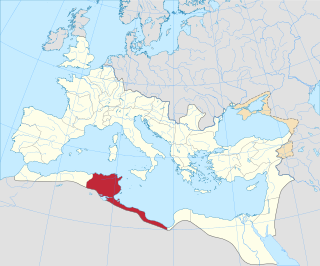Related Research Articles
Aprus or Apros, also Apri or Aproi (Ἄπροι), was a town of ancient Thrace and, later, a Roman city established in the Roman province of Europa.

Hersonissos, also transliterated as Chersonissos and Hersónisos, is a town and a local government unit in the north of Crete, bordering the Mediterranean / Aegean Sea. The town is about 25 kilometers east of Heraklion and west of Agios Nikolaos. What is usually called Hersonissos is in fact its peninsula and harbour. It is part of the Heraklion regional unit. It is situated 25 km from the Heraklion airport and 27 km from the Heraklion port. The seat of the local government unit is the village of Gournes.

Castulo was an Iberian town and bishopric (now Latin titular see located in the Andalusian province of Jaén, in south-central Spain, near modern Linares.
Magydus was a city and bishopric of ancient Pamphylia on the Mediterranean coast of southwestern Asia Minor. It is probably the same as Mygdale (Μυγδάλη) described in the Stadiasmus Maris Magni.

Olba or Olbe was an ancient city and bishopric in the Roman province of Isauria, in present-day southern Turkey. It is included in the Catholic Church's list of Latin titular sees.
Harpasa was a city and bishopric in ancient Caria in Roman Asia Minor, which only remains a Latin Catholic titular see.
Tigava was an ancient Roman-Berber town and bishopric in Roman Africa, which remains a Latin Catholic titular see.
Sidyma, was a town of ancient Lycia, at what is now the small village of Dudurga Asari in Muğla Province, Turkey. It lies on the southern slope of Mount Cragus, to the north-west of the mouth of the Xanthus.
Bononia, once the residential episcopal see of the city of that name, is a titular see of the Catholic Church.

The Diocese of Guadix is a Latin suffragan diocese of the Catholic Church in the ecclesiastical province of Granada in Andalusia, southern Spain and a Latin titular bishopric under its Ancient name of Acci. Its cathedral episcopal see is Nuestra Señora de la Anunciación, dedicated to Our Lady of the Annunciation, in the city of Guadix, administrative province of Granada. It was commenced in 1710, on the site occupied by the principal mosque, and completed in 1796.
The Roman Catholic Diocese of Suacia was a bishopric with see in the town of Svač, which is today the village lying to the east of Ulcinj in Montenegro that is called in Serbian Шас, in Croat Šas and in Albanian Shas.
Traianopolis, Trajanopolis, Tranopolis, or Tranupolis was a Roman and Byzantine city in Phrygia Pacatiana Prima.
Rucuma is a former city and bishopric in Roman North Africa, which remains a Latin Catholic titular see.
Dalisandus or Dalisandos was an ancient city and bishopric in eastern Pamphylia, in Asia Minor and remains a Latin titular see.
The Roman Catholic Diocese of Gravelbourg was a Latin suffragan of the Archdiocese of Regina and presently a Latin Catholic titular see.

The Roman Catholic Diocese of Baeza was a Visigothic Catholic bishopric, suppressed under Moorish rule and shortly restored in the 13th century, which remains a Latin titular see.
Chersonesus in Europa was an Ancient city and bishopric and is now a Latin Catholic titular see in Turkish Thrace, near modern Hexamili.
Dionysiopolis or Dionysopolis, was a city of Phrygia in Asia Minor. The demonym Dionysopolitae (Διονυσοπολίτης) occurs on coins, and in a letter of M. Cicero to his brother Quintus, in which he speaks of the people of Dionysopolis being very hostile to Quintus, which must have been for something that Quintus did during his praetorship of Asia. Pliny places the Dionysopolitae in the conventus of Apamea, which is all the ancient writers note of their position. We may infer from the coin that the place was on the Maeander, or near it. Stephanus of Byzantium says that it was founded by Attalus and Eumenes. Stephanus mentions another Dionysopolis in Pontus, originally called Cruni, and he quotes two verses of Scymnus about it; however, the town of Dionysupolis in Thrace but on the Pontus, rather than in Pontus could be meant.

Dura was an ancient city and bishopric in Roman North Africa, which remains a Latin Catholic titular see.

Horta was a city and bishopric in Roman Africa, which only remains as Latin Catholic titular see.
References
- ↑ William Smith, Dictionary of Greek and Roman Geography (1854), entry "Limenae"
- ↑ Cf. Wiktionary
- ↑
 Smith, William, ed. (1854–1857). "Limenae". Dictionary of Greek and Roman Geography . London: John Murray.
Smith, William, ed. (1854–1857). "Limenae". Dictionary of Greek and Roman Geography . London: John Murray. - 1 2 Annuario Pontificio 2013 (Libreria Editrice Vaticana 2013 ISBN 978-88-209-9070-1), p. 917
- ↑ Travel in Anatolia Archived 2014-01-06 at the Wayback Machine
- ↑ Hoyran (Limenia) Island
- ↑ http://www.gcatholic.org/dioceses/former/t1027.htm GCatholic
![]() This article incorporates text from a publication now in the public domain : Smith, William, ed. (1854–1857). "Limenae". Dictionary of Greek and Roman Geography . London: John Murray.
This article incorporates text from a publication now in the public domain : Smith, William, ed. (1854–1857). "Limenae". Dictionary of Greek and Roman Geography . London: John Murray.